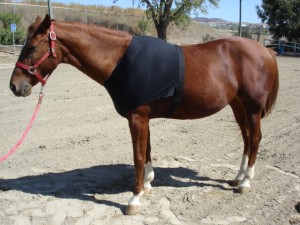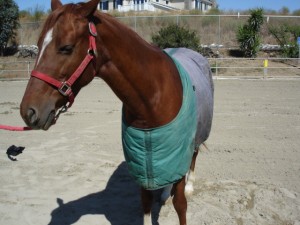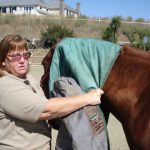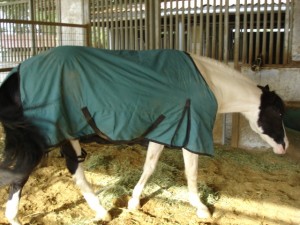
Let’s Blanket Your Horse!
You are ready to blanket! You made the decision to blanket and purchased the correct ones. It’s time! My horses are usually kept blanketed due to their work schedule. My school horses often do lessons in the evening and are sweaty afterward. My students can put their blanket on and don’t need to spend hours walking them. I have one mare, Lace that needs to be shaved because she grows a very heavy coat. Lace also wears a shoulder guard to prevent blanket rubs. The kids call it her “sports bra”.
All of my horses have three blankets- a day sheet and two mid-weight stable blankets. I live in Southern California and the stalls are fully covered, so no real weather issues here. I always have extra blankets on hand in case a client’s horse breaks his blanket or it becomes too soiled to use. I blanket according to the temperature, not time of day. I often see people removing their horse’s blanket as they dash off to work in the morning. That may be fine some days, but often it’s colder when they take if off than it was when they put it on! Not the best time to be removing a blanket, don’t you think? We check the thermometer several times each day and put blankets on or take them off when it gets to about 60 degrees. If it is a cool, rainy day the blankets may stay on all day. If the blankets are on during the day, I check them often to be sure the horses aren’t too hot. Some horse’s blankets are removed before the temperature hits 60 degrees because it’s heavier or they have a long coat. Other horses will wear their blanket later in the day because they are shaved or the blanket is lighter weight. This is how we conduct the Blanket Service at CRK Training Stable. If you or your barn managers aren’t doing these things, perhaps it’s time for a change.
When blanketing your horse always remember- Safety First! Make sure you can control the horse. The last thing you want is to get kicked or have the horse walk away with the blanket half on and the straps dragging under him. If you need to put on a halter and hold the horse, do it. If you need a helper, get one. There is lots of potential for both horse and handler to get hurt here. Better safe than sorry.
Next, determine if you are going to put the blanket over the horses head or not. If it’s a closed front blanket, you don’t have a choice. Over the head it goes. If it has front straps that stay closed, make sure they are buckled and adjusted for the horse.
Follow these simple steps to put a blanket on over the horses head.-
1. Hold the blanket in front of the horse like a bib. If you are holding the horse, put the lead rope through the blanket first. Then, gently and quickly slip the closed front section or chest-straps over his head.
2. Pull the blanket up onto his back and smooth it all the way to the tail.
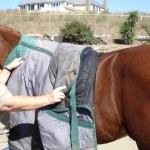
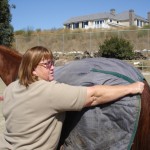
3. Buckle the belly straps according to their configuration.
4. Attach the leg straps last.

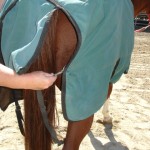
If you have an open front blanket, the steps are slightly different. Here’s how-
Fold the blanket into thirds widthwise.
Gently swing the folded blanket onto the horses back like you would a saddle. Leave it folded on the horses back. If your horse won’t tolerate a flying blanket, gently place the folded blanket on his back and adjust from there.
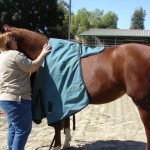
Pull it far enough forward to buckle the front straps securely.
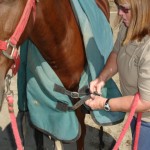
After the front is buckled, pull the blanket all the way back to the tail. Then continue as above.
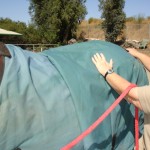
A Note on Straps-
Blanket straps come in lots of different configurations. The straps on the blankets always seem to be some sort of elaborate puzzle designed to confuse and confound horse owners. Front straps– These straps should close the blanket completely but not be so tight as to choke the horse. Even on open front blankets, I usually leave these straps buckled and pull the blanket over the horses head. Side Straps– The simple explanation is this: If the straps are set at an angle (like an open V), they need to be crossed under the belly. If the straps are set straight up and down ( I I ) , they don’t cross. If there is only one, you should be able to figure it out yourself. If you have a gelding or stallion be sure the straps don’t put pressure on his sheath. You don’t want him to stop urinating because the straps are preventing him from “dropping”. Leg Straps- Most blankets these days have leg straps that go around the hind legs. These straps are important because they keep the blanket from shifting. I personally prefer the type that can be detached from the blanket completely. If they break, they are easily replaced. I have even been known to use bailing twine in a pinch. I also like that they can be buckled without having to go to the off (right) side of the horse. This saves time when I have 20 horses to blanket and is much safer. Some horses really object to being blanketed. I don’t want to give them a chance to demonstrate their displeasure by landing a well placed kick as I squeeze behind them. Or pinning me to the wall while I’m reaching for a strap. Even the kind, gentle ones might be annoyed at having to leave their dinner so you can get to the other side and buckle straps. This can lead to blanketing issues that I would rather not create. To cross or not to cross? I cross the leg straps on geldings (i.e. Left strap goes between the hind legs and attaches on the right side and vise-versa). I don’t cross the straps on mares (Right strap goes between the hind legs and attaches on the same side). Crossing the straps keeps the blankets on better, but on mares, not crossing the straps keeps them cleaner due to the mare’s anatomy. If you have any more questions about that, call me.
It’s time to take the blanket off-
To remove the blanket, remember- Safety First! Halter the horse and hold or tie as needed.
1. Unbuckle the hind leg straps first, belly straps second and the chest straps last.
2. Fold the blanket in thirds as you move it from the tail to the withers.
3. Remove the folded blanket, either off the horses’ side or over the head.
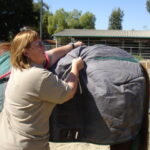
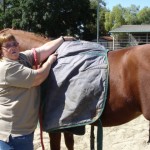
Store the folded blanket away from the horse. One of my horses thinks they make a tasty afternoon snack. Others believe they make wonderful throw rugs and lousy stall-wall hangings. Still others prefer to ignore them and hope they go away altogether. Either way, be sure your blanket is stored in a way to keep it safe and clean. With proper care, blankets can last many years making them a very worthwhile investment.

